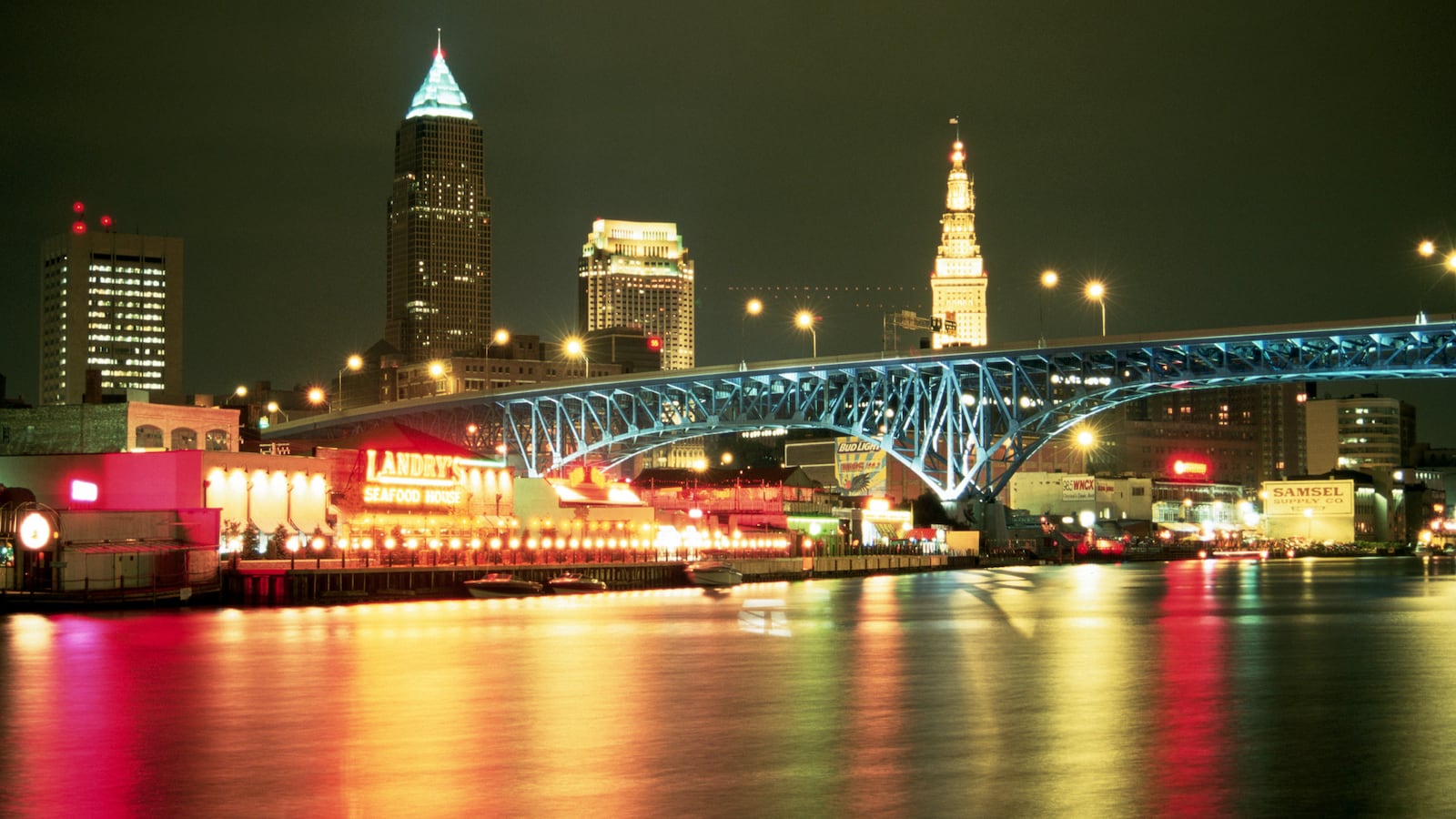The Grand Canyon. Yellowstone. Great Smoky Mountains. These are usually the first places that come to mind when people talk about national parks in the United States. Maybe Cuyahoga Valley National Park in Ohio is lesser known, and doesn’t have a supervolcano underneath it or bison roaming its fields, but its history is no less captivating.
At the heart of that story is the Cuyahoga (“crooked”) River, which begins in pristine Amish Country, winding its way through small towns, the national park, around Cleveland, and into Lake Erie. The river’s story shows that cities only succeed when their natural resources succeed.
Decades ago, the river was so polluted that the few fish living in it were dangerous to eat—also, there was the fact that the river, or rather the things in it, periodically caught on fire.
Standing in Cleveland or Cuyahoga Valley National Park today, it is hard for me to imagine this river being so deadly. At the national park, there are multiple waterfalls, and tributaries connecting to it, extensive hiking and biking trails meandering through fantastic forest landscapes that follow the river and have quaint stops at farmer’s markets, art shows, and concerts.
Cuyahoga Valley National Park always feels magical.
Its emerald lichen and moss covered The Ledges—a rocky outcropping that overlooks a large portion of the park—always transported me out of the flat farmlands of Northwest Ohio. (It is also one of the oldest protected areas of the park.) During the fall, The Ledges becomes a sort of performance hall, from which one can watch a sea of tree canopies proudly showboating a spectrum of oranges, reds, and yellows.
Cleveland, just a short ride north, has also risen to the level of being a destination and is revitalizing. It is home to growing ecotourism, popular restaurant and night scenes, as well as celebrated breweries like Great Lakes Brewing Company which—known for its Annual Burning River Fest—invests in green initiatives like regional water quality in Lake Erie and the Cuyahoga River.
But things were not always this way.
At the invitation of Destination Cleveland, I visited the city for the 50th anniversary of the last Cuyahoga River fire. I discovered that, while I was raised in Ohio, I really had no idea how hard the national park and the city had to work to be what it is now.
Cleveland’s early problems were emblematic of the modern world and fueled by the city’s quick rise to prominence.
Early in the last century, Cleveland was the 5th largest city in the United States. It was seen as a shining example of industry and American progress. The Cuyahoga River, unfortunately, took on the burden of ingesting the pollution of that progress, complete with debris soaking in toxic and flammable chemicals.
The last fire on June 22, 1969, though not the biggest, was still a symbol of how far the city had fallen. The Cuyahoga River was so polluted that TIME Magazine once said “it oozes rather than flows.” One Clevelander joked that no one drowns in the Cuyahoga, they “decay.”
America’s one-time poster-child became “the mistake by the lake”—even to other Ohioans. The reputation stuck and even fifty years later it is still how some think of it. A recently shared photo of the city shrouded in a post-thunderstorm fog from my hotel room in the Hilton, for example, led a Facebook commenter to joke “Cleveland never looked better.” The city continues to work hard to shed that toxic memory.
A few things helped to create this relentlessly negative reputation.
First, the last river fire of 1969 was smaller than earlier fires and was put out before the press could arrive and take photos, so national news outlets like TIME Magazine used a photo from a much larger 1952 fire. This flaming image amplified the crisis in a way the actual fire may not have if reporters had been there to get photos. Also, Cleveland was already the focus of national news, as the newly elected Carl B. Stokes was the first elected African American U.S. mayor. This was an historical moment, which brought with it a lot of national media scrutiny.
But most importantly, the cultural timing was just right; the national conversation was changing.
The 1969 fire on the Cuyahoga River is sometimes portrayed in the press as the thing igniting an environmental revolution. It is almost a messianic figure for some—a river that died so that others may live. This is hagiography though—a sensationalization. (And to be fair, local representatives that I met during the anniversary celebration focused on a tempered and historically driven story.)

"Firemen stand on a bridge over the Cuyahoga River to spray water on the tug Arizona, as a fire, started in an oil slick on the river, sweeps the docks at the Great Lakes Towing Company site in Cleveland Nov., 1st."
Bettmann/GettyYes, Cuyahoga River and national attention on Cleveland’s pollution issues did help draw attention to America’s larger ecological problems, but not by themselves. The fire occurred at a moment when the environmental movement was already picking up steam nationally and in Ohio.
U.S. rivers in cities like Baltimore, Buffalo, and Philadelphia, for example, were also polluted with debris and catching on fire. Attempts were already underway to clean things up in Ohio, especially for Lake Erie, a major source of drinking water. In 1968, Mayor Stokes saw the river’s pollution as a blight on the city’s reputation and Cleveland voted to approve a $100 million bond for cleanup.
This bond was a major, unparalleled move. “By comparison,” as Case-Western’s law professor, Jonathan Adler notes in The Washington Post, “in 1968 the federal government only spent $180 million nationwide on water quality and pollution control efforts and was still mostly concerned with ensuring navigability of waterways, even at the expense of maintaining water quality.”
But probably no less important for raising environmental awareness was the role of deindustrialization, as University of Cincinnati Professor of History David Stradling and his brother, journalist Richard Stradling have pointed out. Deindustrialization in the city meant the area was leaking residents and jobs. As industry employers left the city, the concern shifted from protecting corporations and jobs to protecting the people’s natural, permanent assets.
At the same time, protecting and conserving natural resources also found new national momentum.
The first Earth Day was celebrated in April of 1970 and before the year was done, Nixon formed the EPA. Just two years later, The Federal Water Pollution Control Act of 1948 was revised to become the Clean Water Act.
Cleveland’s problems really just helped to highlight the larger issue already underway, but its part in that story sullied its name for decades. During those years, it has worked extraordinarily hard to resurrect its river and reputation.
In the early 70s, for example, Dr. Seuss’s first edition of The Lorax contained a line aimed at the region’s pollution. It reads: “They’ll walk on their fins and get woefully weary, in search of some water that isn’t so smeary, I hear things are just as bad up in Lake Erie.”
In 1985, two graduate students petitioned Dr. Seuss to have the line removed, noting the region’s ongoing cleanups. He agreed to remove it in future editions.
So at the 50th anniversary celebration of Cuyahoga’s last fire, I found Cleveland to be a city working to earn its rebranding as a destination.
This is not, however, to gloss over the overall work that the city has ahead of itself.
Cleveland’s crime statistics are still among the highest in the country, according to Neighborhood Scout. Though it is worth noting that Cleveland police statistics show an ongoing decrease in violent crimes. Cleanup and blight removal is ongoing. However, according to a report earlier in the year, while gentrification is usually a top issue in many places where revitalization is occurring, in the Cleveland area population loss, neighborhood abandonment, and poverty concentration are the rising concerns.
Still, the reawakening of the Cuyahoga River is no small feat. Once lifeless, unsafe, and avoided by residents, it is now a central part of city life and tourism, where food culture is booming and restaurants offer river views. Kayakers and paddle boaters can enjoy the river and cyclists make use of trails that follow the river south toward Cuyahoga Valley National Park.
But for my money, one important takeaway from Cleveland’s story is that the vitality of a city is never disconnected from its natural resources. Cleveland’s success is inextricably tied to what is happening upstream in the national park.
Cuyahoga Valley National Park was birthed in those environmental concerns of the 1970s.
When President Gerald Ford established it as a recreation area in 1974, it was only the first step in the park’s decades of acquiring land, removing dump sites, cleaning up waste, and reducing sewage run-off. Environmentalists hoped to preserve natural spaces in Ohio for recreation against Cleveland’s urban expansion and industrial development. It only received the national park designation in the year 2000.

A clean Cuyahoga today.
Brandon WithrowDevelopment and pollution had pushed out animal and plant life, and it was the park’s mandate to set it right. They replanted vegetation, restored river banks, and controlled erosion. They are currently in the process of removing old dams that lock in fish populations and stand in the way of creating a viable water trail for water sports.
The park that I, and millions of other visitors, enjoy each year, with its fantastic gorges and wooded river banks has experienced its own transformation, thanks to its work with neighboring cities, metroparks, and local farms.
In other words, it takes several villages to restore and preserve a natural resource.One of those farms, for example, Spice Acres, owns Spice Kitchen & Bar in Cleveland. The restaurant’s continually evolving farm to table menu is itself a wonderful menagerie of local flavors, as approximately 80 percent is sourced within 150 mile radius, according to the company.
But when it comes to the area’s restoration efforts, the most telling—and surprising—metric is that in March it was announced that for the first time in decades, maybe even a century, fish caught from the Cuyahoga River are safe to eat again. That is a milestone that should never have needed to be one.
U.S. citizens live in a time when progress is seen by the Trump administration as returning to the days of polluting industries and opening up natural resources to drilling and exploitation, where corporations get priority over the pressing issues of climate change, and where many people are willing to step back into a short-sighted past. Deregulation is even lauded as a victory, as if corporations will always do what is right when not being watched.
Fifty years later, the Cuyahoga River is one cautionary tale among many. It is a reminder that all of the natural world is connected and that a river that oozes, or is so polluted that it catches on fire, may bring jobs for a short while, but it is bad for the life around it forever.
“When we try to pick out anything by itself,” as John Muir once said, “we find it hitched to everything else in the Universe.”

